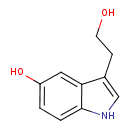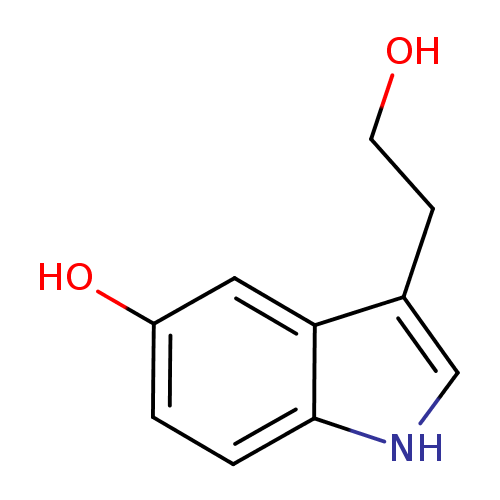|
Record Information |
|---|
| Version |
1.0 |
|---|
| Update Date |
1/22/2018 11:54:54 AM |
|---|
|
Metabolite ID | PAMDB120397 |
|---|
|
Identification |
|---|
| Name: |
5-hydroxytryptophol |
|---|
| Description: | 5-Hydroxytryptophol is a relatively minor metabolite of serotonin that is excreted primarily as the glucuronide conjugate in human urine. 5-Hydroxytryptophol becomes more important quantitatively during alcohol intoxication, when a shift in the metabolism of serotonin occurs from 5-hydroxyindole acetic acid toward increased (15-fold higher) formation of 5-hydroxytryptophol due to the inhibition of aldehyde dehydrogenase by ethanol-derived acetaldehyde. Urinary excretion of 5-hydroxytryptophol has also been shown to be markedly increased for several hours following intake of foods rich in serotonin, such as bananas. Wide interspecies variation has been reported in the metabolism serotonin to 5-hydroxytryptophol; 5-Hydroxytryptophol makes up 35% of the excreted serotonin metabolites in the rat on average and 10 to 20% in several other species. Human UDP-glucuronosyltransferase 1A6 (UGT1A6) plays a predominant role in the glucuronidation of 5-hydroxytryptophol by human liver microsomes. (PMID 15258112 ). |
|---|
|
Structure |
|
|---|
| Synonyms: | - hydroxytryptophol
- 5-hydroxyindole-3-ethanol
- 5-hydroxy-1H-indole-3-ethanol
- 1H-indole-3-ethanol
- 5-hydroxy-indole-3-ethanol
|
|---|
|
Chemical Formula: |
C10H11NO2 |
|---|
| Average Molecular Weight: |
177.202 |
|---|
| Monoisotopic Molecular
Weight: |
177.07898 |
|---|
| InChI Key: |
KQROHCSYOGBQGJ-UHFFFAOYSA-N |
|---|
| InChI: | InChI=1S/C10H11NO2/c12-4-3-7-6-11-10-2-1-8(13)5-9(7)10/h1-2,5-6,11-13H,3-4H2 |
|---|
| CAS
number: |
154-02-9 |
|---|
| IUPAC Name: | 3-(2-hydroxyethyl)-1H-indol-5-ol |
|---|
|
Traditional IUPAC Name: |
hydroxytryptophol |
|---|
| SMILES: | C(O)CC1(=CNC2(=C1C=C(O)C=C2)) |
|---|
|
Chemical Taxonomy |
|---|
|
Taxonomy Description | This compound belongs to the class of chemical entities known as hydroxyindoles. These are organic compounds containing an indole moiety that carries a hydroxyl group. |
|---|
|
Kingdom |
Chemical entities |
|---|
| Super Class | Organic compounds |
|---|
|
Class |
Organoheterocyclic compounds |
|---|
| Sub Class | Indoles and derivatives |
|---|
|
Direct Parent |
Hydroxyindoles |
|---|
| Alternative Parents |
|
|---|
| Substituents |
- 3-alkylindole
- Hydroxyindole
- Indole
- 1-hydroxy-2-unsubstituted benzenoid
- Substituted pyrrole
- Benzenoid
- Heteroaromatic compound
- Pyrrole
- Azacycle
- Organic oxygen compound
- Alcohol
- Primary alcohol
- Organooxygen compound
- Organonitrogen compound
- Organic nitrogen compound
- Hydrocarbon derivative
- Organopnictogen compound
- Aromatic heteropolycyclic compound
|
|---|
| Molecular Framework |
Aromatic heteropolycyclic compounds |
|---|
| External Descriptors |
|
|---|
|
Physical Properties |
|---|
| State: |
Solid |
|---|
| Charge: | 0 |
|---|
|
Melting point: |
Not Available |
|---|
| Experimental Properties: |
| Property | Value | Reference |
|---|
| Melting Point | Not Available | Not Available | | Boiling Point | Not Available | Not Available | | Water Solubility | Not Available | Not Available | | LogP | Not Available | Not Available |
|
|---|
| Predicted Properties |
|
|---|
|
Biological Properties |
|---|
| Cellular Locations: |
Not Available |
|---|
| Reactions: | |
|---|
|
Pathways: |
Not Available |
|---|
|
Spectra |
|---|
| Spectra: |
| Spectrum Type | Description | Splash Key | |
|---|
| LC-MS/MS | LC-MS/MS Spectrum - Quattro_QQQ 10V, Positive (Annotated) | splash10-01t9-0900000000-438566644fd2e8ec412e | View in MoNA |
|---|
| LC-MS/MS | LC-MS/MS Spectrum - Quattro_QQQ 25V, Positive (Annotated) | splash10-03di-0900000000-8baec8b2c7b82d489fc8 | View in MoNA |
|---|
| LC-MS/MS | LC-MS/MS Spectrum - Quattro_QQQ 40V, Positive (Annotated) | splash10-07vi-0900000000-c7bb9d840b92b2e189ef | View in MoNA |
|---|
| Predicted LC-MS/MS | Predicted LC-MS/MS Spectrum - 10V, Positive | splash10-03fr-0900000000-db5db754e226df916966 | View in MoNA |
|---|
| Predicted LC-MS/MS | Predicted LC-MS/MS Spectrum - 20V, Positive | splash10-03di-0900000000-dd31d267f7f54ef4d1c6 | View in MoNA |
|---|
| Predicted LC-MS/MS | Predicted LC-MS/MS Spectrum - 40V, Positive | splash10-02ai-1900000000-784614cb940ba83ab52e | View in MoNA |
|---|
| Predicted LC-MS/MS | Predicted LC-MS/MS Spectrum - 10V, Negative | splash10-004i-0900000000-2e8fd5660c103ab7f3cb | View in MoNA |
|---|
| Predicted LC-MS/MS | Predicted LC-MS/MS Spectrum - 20V, Negative | splash10-002b-0900000000-2ce11ad613dbaf000b6a | View in MoNA |
|---|
| Predicted LC-MS/MS | Predicted LC-MS/MS Spectrum - 40V, Negative | splash10-001i-2900000000-39a645eb4fa1a2571f5c | View in MoNA |
|---|
| 1D NMR | 1H NMR Spectrum | Not Available |
|---|
| 2D NMR | [1H,13C] 2D NMR Spectrum | Not Available |
|---|
|
|---|
|
References |
|---|
| References: |
- Curtius HC, Wolfensberger M, Redweik U, Leimbacher W, Maibach RA, Isler W: Mass fragmentography of 5-hydroxytryptophol and 5-methoxytryptophol in human cerebrospinal fluid. J Chromatogr. 1975 Oct 29;112:523-31. [1184685 ]
- Krishnaswamy S, Hao Q, Von Moltke LL, Greenblatt DJ, Court MH: Evaluation of 5-hydroxytryptophol and other endogenous serotonin (5-hydroxytryptamine) analogs as substrates for UDP-glucuronosyltransferase 1A6. Drug Metab Dispos. 2004 Aug;32(8):862-9. [15258112 ]
|
|---|
| Synthesis Reference: |
Da Prada, M.; Bartholini, G.; Pletscher, A. Formation of 5-hydroxytryptophol by blood platelets after thrombin and reserpine. Experientia (1965), 21(3), 135-6. |
|---|
| Material Safety Data Sheet (MSDS) |
Download (PDF) |
|---|
|
Links |
|---|
| External Links: |
|
|---|


